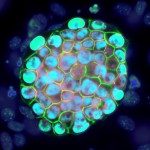The emergence of discrete cell identities from undifferentiated precursor cells is a central process in development and tissue homeostasis and repair, that when defective is at the basis of many human conditions including cancer and aging. The goal of our research is to provide a better understanding of the regulations operating at the levels of both intrinsic programs and extrinsic cues to ensure acquisition and maintenance of cell identities in an in vivo context. We are using as a model of choice the mouse preimplantation embryo, for which in vivo cell fate decisions can be scrutinized with high spatiotemporal resolution thus allowing to probe how dynamic changes in spatial cues and gene expression program are resolved into distinct cell identities in the intact embryo. In mammals, placental viviparity imposes on embryo development to begin with the generation of extraembryonic lineages required to interact with the maternal tissues, namely trophectoderm (TE) and primitive endoderm (PrE), while preserving a small population of pluripotent epiblast (Epi) cells from which the embryo proper originates. Understanding how these three lineages are produced in the proportion and arrangement appropriate for post-implantation development to proceed is of paramount importance in the context of the continuous decline of human fertility and increasing use of medically assisted reproductive technologies.
Click to view graph
Connections
Click to view timeline
Timeline
About
Courses
Pasteur Course Mouse genetics for disease modelling
This five-week intensive course, featuring both laboratory work and lectures, explores the analysis of gene function at multiple levels: from the gene and its product, to the cell and its interactions, to embryonic tissues […]
2026-01-05 21:00:00
2026-02-13 18:00:00
Europe/Paris
Pasteur Course Mouse genetics for disease modelling
This five-week intensive course, featuring both laboratory work and lectures, explores the analysis of gene function at multiple levels: from the gene and its product, to the cell and its interactions, to embryonic tissues […]
Institut Pasteur, Rue du Docteur Roux, Paris, France
Mouse Genetics for Disease Modelling Course
This five-week intensive laboratory and lecture course covers the analysis of gene function at all levels: the gene and its product, the cell and its interactions, the embryonic tissues and the entire animal. This […]
2024-01-08 09:00:00
2024-02-13 18:00:00
Europe/Paris
Mouse Genetics for Disease Modelling Course
This five-week intensive laboratory and lecture course covers the analysis of gene function at all levels: the gene and its product, the cell and its interactions, the embryonic tissues and the entire animal. This […]
Institut Pasteur, Rue du Docteur Roux, Paris, France
Transversal Projects
Projects
Tools
Publications
Download-
2025Recurrent Evolutionary Innovations in Rodent and Primate Schlafen Genes., Genome Biol Evol 2025 Sep; 17(10): .
-
2025PI3K/AKT signaling controls ICM maturation and proper epiblast and primitive endoderm specification in mice., Dev Cell 2025 Jan; 60(2): 204-219.e6.
-
2024Nr5a2 is dispensable for zygotic genome activation but essential for morula development, Science, 2024, 386 (6717), pp.eadg7325. ⟨10.1126/science.adg7325⟩.
-
2024Molecular and epistatic interactions between pioneer transcription factors shape nucleosome dynamics and cell differentiation, 2024.
-
2024Recurrent Evolutionary Innovations in Rodent and Primate Schlafen Genes, 2024.
-
2023PI3K/AKT signalling orchestrates ICM maturation and proper epiblast and primitive endoderm specification, 2023.
-
2023Nr5a2 is essential for morula development, 2023.
-
2022H3K9 tri-methylation at Nanog times differentiation commitment and enables the acquisition of primitive endoderm fate., Development 2022 Sep; 149(17): .
-
2022OCT4 activates a Suv39h1-repressive antisense lncRNA to couple histone H3 Lysine 9 methylation to pluripotency., Nucleic Acids Res 2022 07; 50(13): 7367-7379.
-
2022NANOG initiates epiblast fate through the coordination of pluripotency genes expression., Nat Commun 2022 Jun; 13(1): 3550.
-
+View full list of publications




















